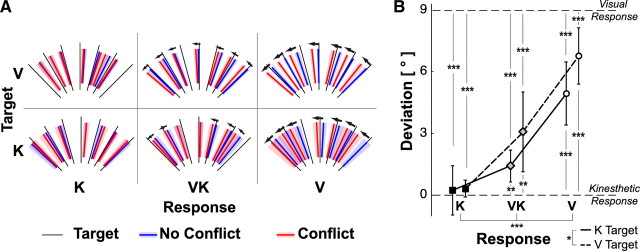Figure 9.
Effect of conflicting information about head tilt. A, Colored lines indicate the response orientation for each target, averaged over all subjects, for each target modality (K, V) and for each feedback condition (K, V, VK) with (red) and without (blue) conflict. Arrows indicate detectable deviations between responses to the same target with and without sensory conflict applied during head movement and the shading around each line represents the corresponding response variability. Data shown here are for one possible value of sensory conflict (9° counterclockwise tilt of the visual scene). B, Deviations induced by the sensory conflict for the two target presentations (visual or kinesthetic) and for the three response feedback conditions (K, VK and V). Deviations of 0° are to be expected if subjects use only kinesthetic or gravitational information to align the response to the remembered target orientation. Deviations of 9° would be expected if subjects aligned the response to the remembered target orientation with respect to the visual scene. Vertical whiskers represent the 0.95 confidence intervals. Stars represent the significance of the main effects in the ANOVA and the results of the t test comparison with the nominal 0° and 9° values. (*p < 0.05, **p < 0.01, and ***p < 0.001).

